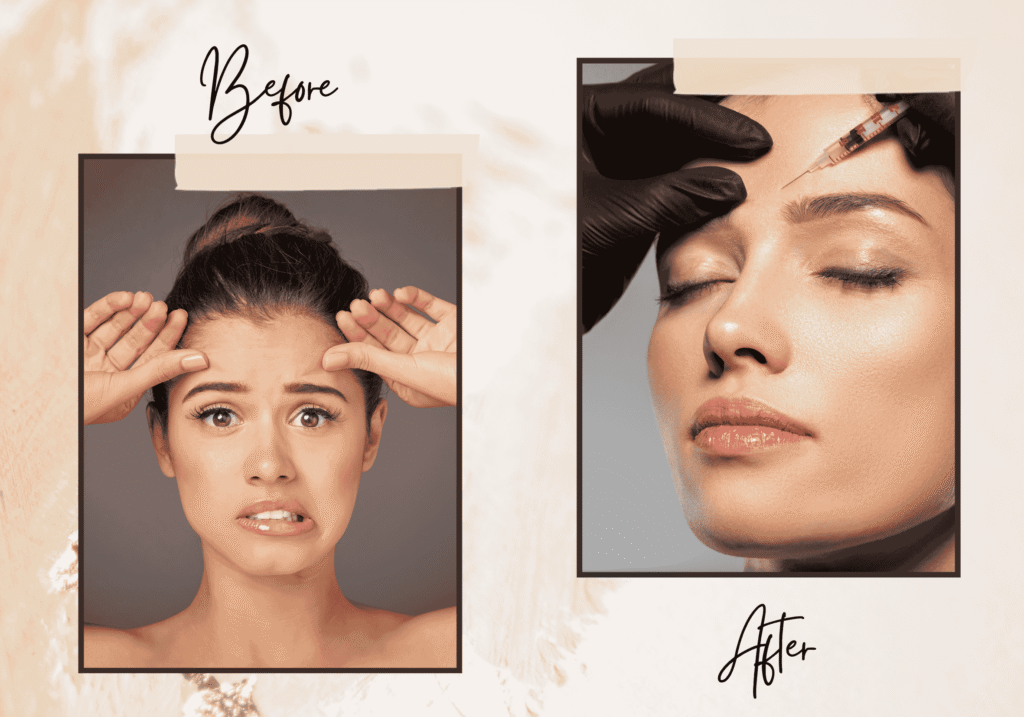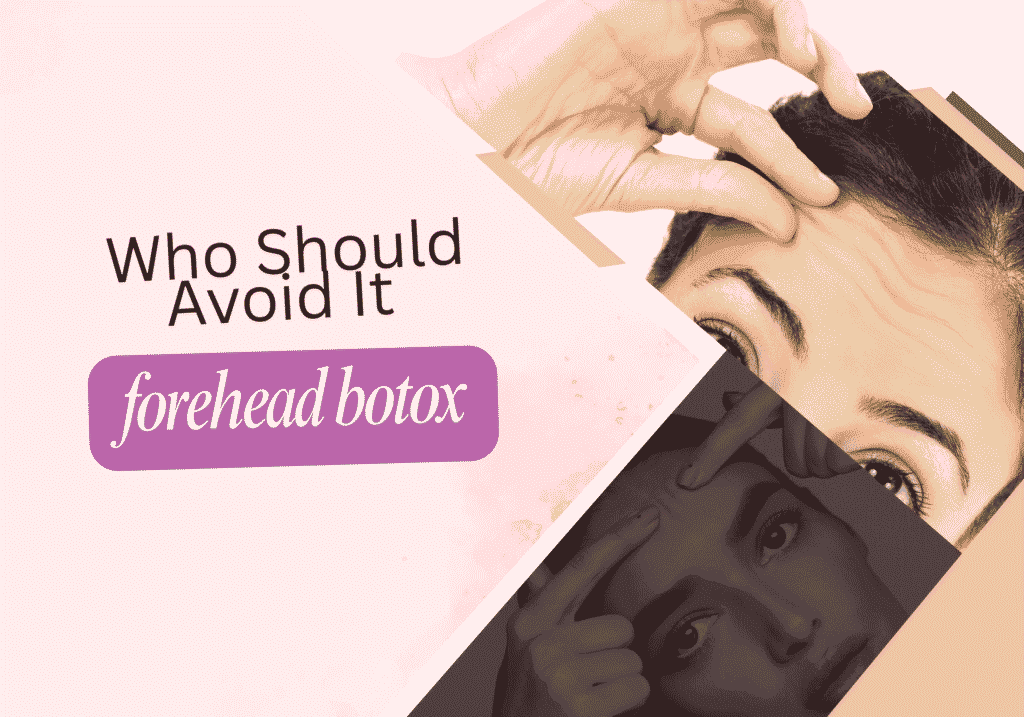Botox on forehead side effects are an important consideration for anyone thinking about this popular cosmetic treatment. Botox injections are widely used to smooth facial wrinkles and rejuvenate the skin, especially on the forehead, where expression lines tend to form early. However, like any medical procedure, Botox carries the risk of side effects—both short-term and long-term. Understanding these Botox side effects on the forehead, seeing what they look like in Botox side effects pictures, and knowing how to manage or prevent them can help you make a confident, informed decision about Botox treatment.
What is Botox and How It works on the Forehead
Botox is a neurotoxin derived from Clostridium botulinum. When injected into muscles, it temporarily blocks nerve signals that cause muscle contractions. In the forehead, Botox targets muscles responsible for horizontal wrinkles and frown lines, relaxing them to smooth the skin’s surface. This Botox cosmetic procedure is quick, minimally invasive, and can provide noticeable Botox results within days.
The forehead is one of the most commonly treated areas because it shows early signs of aging and dynamic wrinkles from repeated facial expressions. Botox injections on the forehead help soften these lines, giving a refreshed, youthful appearance without surgery.
Common Side Effects of Botox on Forehead

While Botox is generally safe when administered by a licensed healthcare provider or board-certified practitioner, some Botox side effects can occur. These are usually mild and temporary.
Immediate Side Effects After Forehead Botox
- Pain, swelling, redness, or bruising at the injection site
- Mild bruising, especially if small blood vessels are affected during injection
- Headache or pressure sensation, which usually subsides quickly
- Tenderness or discomfort near the injection area
These Botox injection site side effects typically appear within the first 24 to 48 hours and improve on their own.
Long-Term Side Effects of Botox on Forehead
Repeated Botox treatments over months or years can lead to longer-term effects that patients should consider.
How Long-Term Botox Affects Skin and Muscles
- Muscle weakening: Continuous muscle relaxation can cause muscle atrophy, potentially softening wrinkle formation but also altering facial expressions.
- Skin thinning: Some patients report subtle changes in skin texture or thinning due to decreased muscle activity and collagen production.
- Changes in forehead movement: Long-term users may notice reduced mobility in the treated areas.

Although uncommon, some Botox adverse effects warrant immediate medical attention:
- Eyelid drooping (ptosis): When Botox migrates beyond the targeted area, it can cause temporary drooping of the eyebrows or eyelids, affecting vision and facial symmetry.
- Asymmetrical eyebrows: Uneven muscle relaxation may create an imbalance, correctable with follow-up Botox treatment.
- Vision changes: Blurred or double vision is rare but serious and should be evaluated promptly.
- Allergic reactions: Though rare, symptoms like rash, itching, or difficulty breathing require urgent care.
Rare Botox side effects needing urgent care include drooping eyelids, uneven eyebrows, vision problems, and allergic reactions. Seek medical help if these occur.
Neurological Side Effects of Botox on Forehead
Some patients worry about the neurological impacts of Botox:
- Nerve pain or numbness in the treated area is rare but has been reported.
- Spread of toxin: In extremely rare cases, the Botox neurotoxin may spread beyond the injection site, causing muscle weakness elsewhere.
Research generally supports Botox’s neurological safety when used correctly, but patients with neuromuscular disorders should exercise caution.
When Do Botox Side Effects Go Away on the Forehead?
Most Botox side effects are temporary:
Side Effects of Botox on Forehead Six Weeks After Injections
Most side effects from Botox injections are temporary and improve on their own within days or weeks.
When Do Botox Side Effects Go Away?
Most side effects from Botox injections are temporary and improve on their own within days or weeks
Typical Recovery Times
- Redness and swelling usually fade within 24 to 72 hours.
- Bruising may take 5 to 10 days to fully disappear.
- Headaches and tenderness often improve within a few days.
- Drooping eyelids or eyebrows generally resolve within 2 to 4 weeks.
While some Botox side effects can be noticeable at first, they typically resolve without lasting issues. If symptoms persist beyond expected timelines, consult your provider.
Risks of Forehead Botox: Who Should Avoid It?

While Botox can be an effective way to smooth forehead lines, it is not suitable for everyone. Certain health conditions and situations can increase the risk of complications.
- Pregnant or breastfeeding women should refrain due to limited safety data.
- People with neuromuscular disorders such as myasthenia gravis are at higher risk of complications.
- Those allergic to botulinum toxin or formulation ingredients should not get Botox.
- Patients with active infections or skin conditions on the forehead should wait until healed.
Botox is generally safe, but it is not recommended for individuals with certain health conditions or allergies. Always consult a qualified provider to assess whether Botox is right for you.
Long-Term Health Concerns of Forehead Botox
Can Botox cause cancer? The current scientific consensus shows no evidence that Botox causes cancer. Botox is FDA-approved for cosmetic and medical use with a strong safety record when administered by trained professionals.
How to Minimize Side Effects of Forehead Botox
Botox forehead treatments can smooth wrinkles effectively, but side effects like swelling or bruising may occur. With proper preparation, aftercare, and a skilled provider, you can minimize these risks and enjoy safe, natural-looking results.
1. Choose a Qualified Injector
Work with an experienced, board-certified medical professional who has a strong record of successful Botox treatments. Expertise significantly reduces the risk of complications.
2. Prepare Before Your Appointment
Avoid alcohol, blood-thinning medications, and anti-inflammatory drugs several days before your session to minimize bruising and swelling. Always consult your provider before stopping any prescribed medication.
3. Follow Aftercare Instructions
Do not rub or massage the treated area. Stay upright for several hours after the procedure, and avoid strenuous exercise for at least 24 hours to prevent Botox from spreading to unintended areas.
4. Schedule Follow-Up Visits
Regular check-ins allow your provider to monitor results and address any issues promptly, ensuring optimal outcomes over time.
Note: Careful provider selection, proper preparation, and strict aftercare can greatly reduce the risk of forehead Botox side effects.
What Happens to Your Forehead After Years of Botox?
Consistent Botox use over several years can lead to both positive and potentially undesirable changes in the forehead area.
Common long-term outcomes include:
- Smoother skin and reduced wrinkles
Continuous muscle relaxation prevents deep crease formation, making existing wrinkles appear softer. - Possible muscle thinning (atrophy)
Long-term inactivity of targeted muscles may cause them to weaken, which can reduce facial expressiveness. - Lower chance of wrinkle recurrence
Wrinkles are less likely to return quickly, but ongoing treatments are usually required to maintain these results.
Long-term Botox use on the forehead often results in smoother skin and softer wrinkles, but it can also cause muscle weakening that reduces facial expressiveness. Wrinkles may be less likely to return, yet continued treatments are needed to maintain the effects.
Is Botox Good for Your Forehead?
Botox can be highly effective for smoothing forehead wrinkles and improving appearance with minimal downtime. However, understanding Botox treatment risks and realistic outcomes is essential. Alternatives include dermal fillers, microneedling, and laser resurfacing, which may be preferred for some skin types or concerns.
FAQs About Botox on Forehead Side Effects
What are the risks of forehead Botox?
Common risks include mild swelling, bruising, headache, and temporary drooping. Serious effects are rare but possible.
What happens to your forehead after years of Botox?
Long-term treatment can soften wrinkles but may reduce muscle tone and facial expressiveness.
Is Botox good for your forehead?
Yes, when done properly, Botox can safely reduce wrinkles and enhance appearance.
Can Botox cause permanent damage?
Permanent damage is extremely rare when administered by qualified professionals.
Final Thoughts on Botox Forehead Side Effects
Botox on forehead side effects are generally mild, temporary, and manageable when experienced professionals perform the procedure. At Diamond Aesthetics, we prioritize your safety and satisfaction by using expert techniques and personalized treatment plans designed to minimize risks while delivering natural-looking results.
Understanding the potential Botox side effects, recovery timelines, and long-term implications can help you make an informed decision about your cosmetic journey. If you are considering Botox for forehead wrinkles or want to discuss your options, our skilled team is here to guide you every step of the way.
Book your consultation today at Diamond Aesthetics to explore safe, effective wrinkle treatments tailored just for you. Visit diamondaesthetics.ca or call us to schedule your appointment and take the first step toward a refreshed, confident you.




